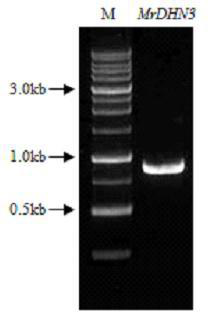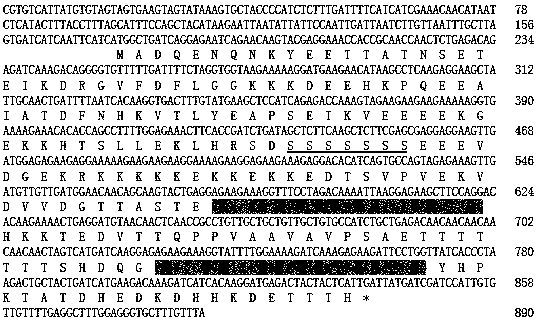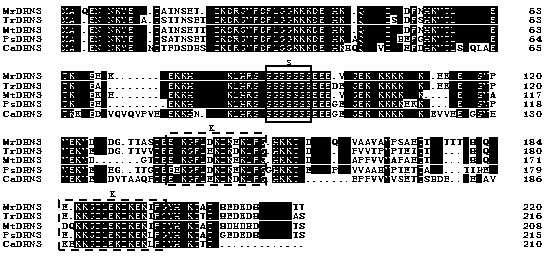Dehydrin Gene of Lentil Bean and Its Application
A technology of dehydrating protein and flat clover beans, applied in the fields of application, genetic engineering, plant gene improvement, etc., can solve the problems of no stress resistance function identification, etc., and achieve the effect of improving salt resistance and heat resistance
- Summary
- Abstract
- Description
- Claims
- Application Information
AI Technical Summary
Problems solved by technology
Method used
Image
Examples
Embodiment 1
[0034] Embodiment 1 linseed bean dehydrin gene, the gene is MdHN3 The coding gene has the nucleotide sequence shown in the 1st to 890th positions of SEQID NO.1 in the sequence listing.
[0035] 1. Alfalfa bean dehydrated protein MdHN3 Gene cloning.
[0036] 1. Low temperature stress treatment and transcriptome sequencing of lentil seedlings:
[0037] ⑴ Low temperature stress treatment of lentil beans:
[0038] After treating the seeds of clover beans with concentrated sulfuric acid for 10 minutes, rinse them with distilled water several times to remove residual sulfuric acid. The above-mentioned treated seeds were placed in a double-layer filter paper petri dish, and germinated under the conditions of 21°C and 16h / 8h photoperiod; 3 days later, the germinated seedlings were transplanted in vermiculite: a mixture of nutrient soil (3:1) Continue to cultivate in the substrate under the above conditions, and irrigate once a week with nutrient solution containing 1 / 2 MS; after...
Embodiment 2
[0120] Embodiment 2 linseed bean dehydrin gene, the gene is MdHN3 The coding gene has a functionally active allele formed by the deletion, insertion or substitution of one or more bases from the first to the 890th position of SEQID NO.1 in the sequence listing.
[0121] Lentil Dehydrated Protein MdHN3 Cloning of the gene and the dehydrin of linseed bean MdHN3 The prokaryotic expression of the gene is the same as in Example 1.
Embodiment 3
[0122] Embodiment 3 Alfalfa bean dehydrin gene, the gene is MdHN3 coding gene, which has figure 2 A protein having the amino acid residue sequence shown in the first to 221st positions of SEQ ID NO.2 in the sequence listing.
[0123] Lentil Dehydrated Protein MdHN3 Cloning of the gene and the dehydrin of linseed bean MdHN3 The prokaryotic expression of the gene is the same as in Example 1.
[0124] right MdHN3 The protein product encoded by the cDNA reading frame consists of 221 amino acid residues with a molecular weight ( mw ) is 24.84 kD, the theoretical isoelectric point ( pI ) is 5.56, and it is an acidic protein. The total average hydrophobicity index Grand average of hydropathicity (GRAVY) is -1.444, which has high hydrophilicity.
[0125] The Pfam database (http: / / pfam.janelia.org) database searched the structural domain of the amino acid sequence encoded by MrDHN3, indicating that the MrDHN3 protein belongs to the LEAII protein family, and there is an S-f...
PUM
 Login to View More
Login to View More Abstract
Description
Claims
Application Information
 Login to View More
Login to View More - R&D
- Intellectual Property
- Life Sciences
- Materials
- Tech Scout
- Unparalleled Data Quality
- Higher Quality Content
- 60% Fewer Hallucinations
Browse by: Latest US Patents, China's latest patents, Technical Efficacy Thesaurus, Application Domain, Technology Topic, Popular Technical Reports.
© 2025 PatSnap. All rights reserved.Legal|Privacy policy|Modern Slavery Act Transparency Statement|Sitemap|About US| Contact US: help@patsnap.com



